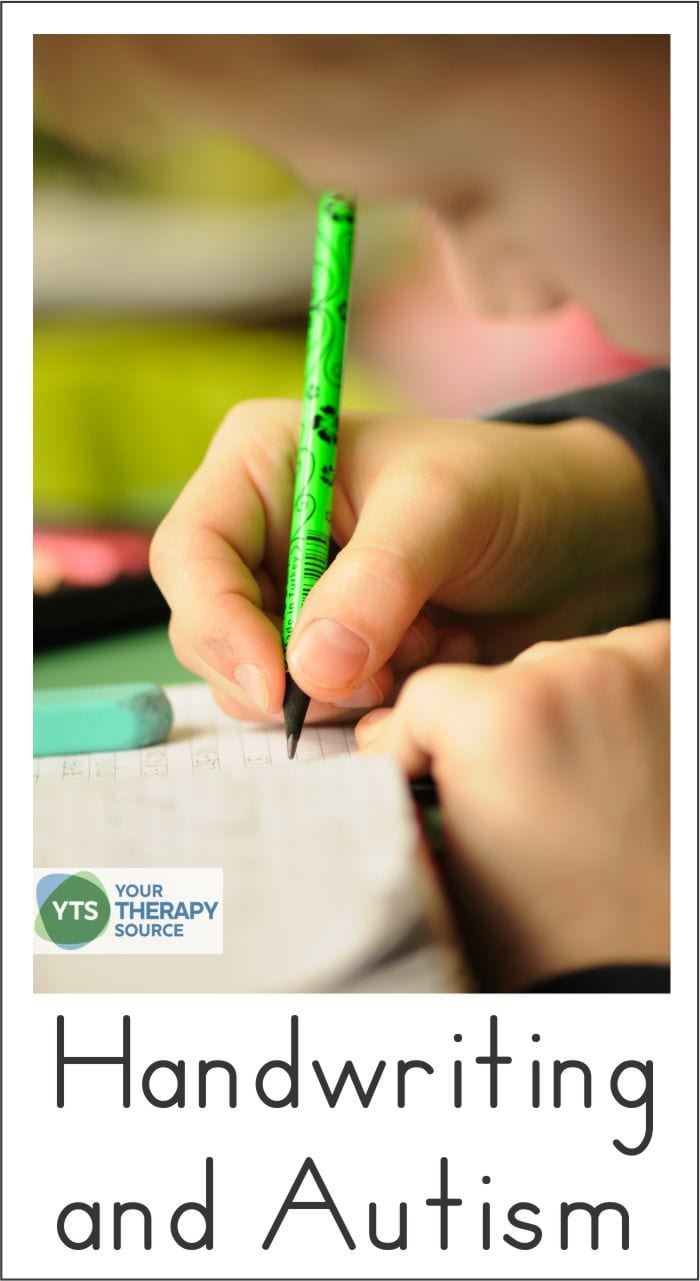Handwriting and Autism
Research in Autism Spectrum Disorders published research on handwriting and autism. The researchers investigated whether handwriting skills in children with autism spectrum disorder (ASD) are related to visual perception, motor coordination, visual-motor integration, and executive functions.
Previous Research on Handwriting and Autism
Previous research provides additional information on handwriting skills:
- in children with autism perceptual reasoning skills were significantly predictive of handwriting skills where motor skills were not.
- children with ASD have a well-automated motor plan for simple handwriting movements when writing guides are present (Johnson, 2015).
- children with autism and those with ADHD had faster handwriting speed but less accurate than controls at each task (Hughes, 2012).
- that children with autism displayed poorer quality in forming letters but size, alignment and spacing were similar to their peers without autism (Fuentes, 2009).
Methodology of this Study on Handwriting and Autism
This recent study evaluated sixty 9-12-year-old children (30 with ASD and 30 typically developing). Testing included the following:
- parents completed the Behavior Rating Inventory of Executive Function (BRIEF) questionnaire.
- the children completed the Beery-Buktenica Developmental Test of Visual-Motor Integration (VMI-V) and performed a story-writing task on a sheet of paper affixed to an electronic tablet to evaluate penmanship.
Results
Following data analysis, significant differences were found between children with ASD and children with typical development in:
- in executive function
- in all BRIEF scales
- visual-motor integration and motor coordination sections of the VMI-V.
There was not a significant difference in the VMI-V visual-perception subtest.
In terms of predicting handwriting, visual-motor integration did not predict handwriting process measures. Executive functions—specifically working memory and shifting—did predict handwriting when writing a story in children with ASD.
The researchers concluded that executive functions, specifically working memory and shifting, play a large role in handwriting production in children with ASD (Rosenblum et al, 2019).
Read more about teaching strategies for students with autism.
Resources to Help with Handwriting
Special Edition for Kids with ASD – Assistive Technology, Classroom Implementation Strategies & Resource Recommendations for Kids Who Struggle to Writedigital download is an assistive technology Resource Guide for OTs, parents and other professionals working with students with Autism Spectrum Disorder, over 50% of whom have educationally significant handwriting challenges that make it difficult/impossible for them to complete written schoolwork using paper and pencil. Research shows that these challenges tend to persist over time, no matter what handwriting therapies have been tried.
Dysgraphia Handwriting Intervention – Occupational Therapy Tools A: Formations digital download is a systematic, structured, efficient, & effective method to re-teach letter and number formation skills. Created by school-based OT, Thia Triggs, this intervention starts at the beginning and will allow you to guide your struggling writer to feel confident and successful, regardless of age.
Do you receive referral after referral for students with handwriting concerns? Are the teachers you work with feeling frustrated and overwhelmed with so little time to offer handwriting practice? ThisHandwriting Station Bundle Deal will save you TONS of time with these NO-PREP activities that encourage handwriting practice for your students. Set up a handwriting station in the classroom or at home so students can practice handwriting throughout the day in the classroom. Great for early finishers!
References:
Hughes, V. Handwriting study points to motor, memory problems in autism. Retrieved on 12/28/12 from Simons Foundation Autism Research Initiative at http://sfari.org/news-and-opinion/conference-news/2012/society-for-neuroscience-2012/handwriting-study-points-to-motor-memory-problems-in-autism.
Johnson, P. et al. Do children with autism and Asperger’s disorder have difficulty controlling handwriting size? A kinematic evaluation. Research in Autism Spectrum Disorders
Volume 11, March 2015, Pages 20–26
Kennedy Krieger Institute. New Study Affirms Handwriting Problems Affect Children with Autism into the Teenage Years. Retrieved from the web on 11/23/2016 from https://www.kennedykrieger.org/overview/news/new-study-affirms-handwriting-problems-affect-children-autism-into-teenage-years
Rosenblum, S., Ben-Simhon, H. A., Meyer, S., & Gal, E. (2019). Predictors of handwriting performance among children with autism spectrum disorder. Research in Autism Spectrum Disorders, 60, 16-24.





